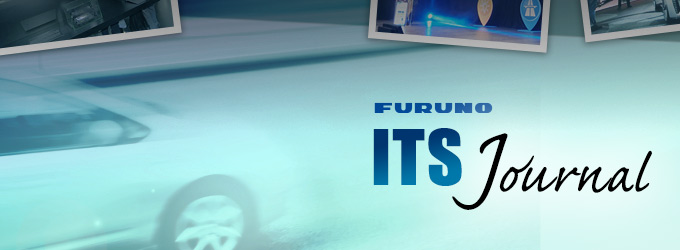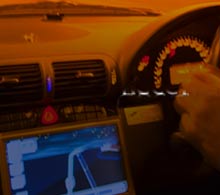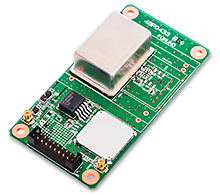Articles for ITS market Drive experience of the latest autonomous vehicle models and advanced driving support systems
 Nissan Skyline with ProPilot 2.0
Nissan Skyline with ProPilot 2.0
 Subaru Levorg with "EyeSight X"
Subaru Levorg with "EyeSight X"
 Honda Legend with "Honda Sensing Elite
Honda Legend with "Honda Sensing Elite
An interim report of the Strategic Innovation Program (SIP)
On April 20 and 21, 2021, the latest models of Autonomous Driving and Advanced Driver Assistance System (ADAS) gathered at the Tokyo waterfront area Odaiba.
The event was a part of the government's Strategic Innovation Program (SIP), providing test drive experience for the press.
Originally planned as a showcase to advertise Japanese technology to the world during the Tokyo Olympics and Paralympics in July 2020, the event was delayed 9 months due to the spread of the COVID19.
A total of eight companies participated in the event; four automakers (Toyota, Honda, Nissan, and Subaru), two overseas auto parts manufacturers (Valeo France and Continental Germany), one venture company (Tia), and one university (Kanazawa University).
I will introduce the above four automakers in the order that I took the test drive.
・Nissan "ProPilot 2.0
The first test vehicle was a Skyline with the ProPilot 2.0 advanced driver assistance system, which was launched in September 2019.
It was the first Japanese model to have a hands-off function in the same lane.
Actually I had test-driven this model before, but this time it was a benchmark for the other tests.
The feature of this product is its high calculation method of the vehicle's position using a high-precision 3D map, "Dynamic Map." It was developed and commercialized through the industry-academia-government collaboration within the country.
The onboard sensor is a Tricam that uses algorithms developed by Mobileye, an Israeli venture under the Intel focus on image recognition technology. The angles of view for short, medium and long distances are set at 150 degrees, 54 degrees and 28 degrees respectively.
In addition, the car is equipped with 77GHz millimeter wave radar for the front, 24GHz millimeter wave radar at the four corners of the car, four cameras for the Around View Monitor, and 12 ultrasonic sensors around the car.
There are two actions during the drive, pressing the ProPilot 2.0 switch and then the set switch, which is the same setup as the normal ProPilot.
Meanwhile the display on the dashboard turns green and if it changes to blue, the conditions to activate ProPilot 2.0 are ready.
If the lane change assist switch on the steering assembly was pressed while ProPilot 2.0 is on, the car automatically changes lanes when the speed difference compared to the car in front was 15km/h or more.
There was no difficulty operating the controls and the activation timing of the various assistance functions is appropriate.
・Subaru "EyeSight X"
For technical details, please refer to the previous article in this column. (Article: Technical of Subaru "EyeSightX")
When compared to Nissan's ProPilot 2.0, Subaru’s EyeSight X took a little more time to reach the required conditions for activation. However, there are some functions unique to EyeSight X, including automatic deceleration at toll gates, which is very useful while driving.
EyeSight X does not use dynamic maps, but rather a unique high-precision 3D map created in collaboration with a map maker. The developers of EyeSight X explained that this helped balance the cost to match the price of a Subaru.
・Honda "Honda Sensing EliteIt is a new model Legend, the world's first level 3 self-driving car.
In level 2 state, the human driver takes primary control. The basic operation method is similar to Nissan and Subaru, press the main switch first. When the dashboard turns green, the ACC (Active Cruise Control) and LKAS (Lane Keeping Assist System) are activated.
If the conditions allow for autonomous drive mode, the dashboard display will turn blue, indicating that hands-off driving is possible.
When the driver presses the button for the advanced lane change support system, the car automatically starts changing lanes after the speed difference with the car in front reaches 15km/h, and then returns to its original lane after overtaking.
In addition, if the speed drops below 30km/h, the Traffic Jam Pilot (traffic jam driving function) will be activated, and from this point on, the automated system takes over vehicle control. The driver can now watch DVDs, operate the navigation system, etc., without the need to constantly monitor the road ahead.
During the test drive, when the Traffic Jam Pilot was activated, the car actually moved very smoothly. I tried to intentionally look in other directions, but somehow it was a strange and uncomfortable feeling. I felt the need to force myself to trust the automated system.
・Toyota "Advanced Drive”
There were two fuel cell vehicles, the Lexus LS500h and the Toyota MIRAI which I tested.
One of the major differences from Nissan, Subaru, and Honda is that the operation to activate, is a single press of the main switch. Also, pressing the main switch twice activates the regular ACC (Active Cruise Control) and LKAS (Lane Keeping Assist System) instead of the “Advanced Drive”.
Even in that case, if the conditions are achieved, the display will ask if the driver wants to switch to the “Advanced Drive”. By selecting "Yes" using the switch of the steering wheel, it will activate the “Advanced Drive”.
Under the “Advanced Drive” mode, the grey display on dashboard indicates hands-on status, and turns blue when hands-off status is enabled.
To switch to the hands-off status, the system needs to recognize the driver's face, so it did not work with a mask. Alternatively, if the mask was put on after the switch to hands-off, the system returned to the hands-on status after a few tens of seconds.
As a result, the Toyota system design has a more stringent setting for driver recognition in the driver monitoring system when compared to Nissan, Subaru, and Honda.
In terms of lane changing, the required conditions and operations were similar to those of Nissan, Honda, and Subaru, but Toyota seemed to be the most cautious company when it came to lane changing.
Another feature of the “Advanced Drive” is that when a destination is set in the navigation system when using a highway, it automatically changes to the lane next to the main exit when approaching the destination.
After the two-day test on the latest systems from the four companies, I felt that aside from Honda's Traffic Jam Pilot, which is a unique system, all companies appointed similar methods in the way they operate the level 2 systems.
This is not surprising, considering the actual demands when driving a car. Aside from that, each company has to appeal their features of their products respectively.
Writer introduction

Mr. Kenji Momota Automotive journalist
His major is the world automotive industry and he is also familiar with the energy industry, IT and the aging society problem as the related fields. He acts around the world based in Japan and USA and writes for the general magazines, the technology journals and the automotive related media etc.
He is also commentator of motor race and world's motor show on TV program based on his career of the driver of Indy Racing League and NASCAR. In recent years, he has been covering about a paradigm shift from developed countries to developing countries, the motorized vehicle like EV and the telematics.
FURUNO ITS Journal
Click here for the latest articles after 2022 (in Japanese)2022
- The "realistic" self-driving roadmap shown by the Japanese government and a hands-on report on the latest Subaru EyeSight X
- Will FCVs (Fuel Cell Vehicles) Become Popular? ~New Movement in Toyota and Honda~
- The 'Complete' online sales of new cars start in Japan. Will this new way of buying cars take root?
- Many Firsts! On-Site Report from Tokyo Auto Salon 2022 - The author, who knows what goes on behind the scenes, looks back on 40 years of history. -
2021
- "Moving toward zero traffic fatalities for four-wheeled and two-wheeled vehicles globally in 2050" ~Experience on Honda's latest safety technologies~
- Tsuneishi Shipbuilding's building and DX, an exclusive visit to the main factory
- Japan's Smart City: New Moves toward Practical Use
- When will self-driving buses (service cars) be put to "full-scale" practical use?
- Utilization vehicle data during disasters
- Toyota-led Connected Technology to Transform Commercial Vehicle Business -From light trucks to large trucks and buses-
- Toyota enters the connected car "Personalization" business
- Japanese automakers' carbon-neutral strategies swept up in ESG investment
- Drive experience of the latest autonomous vehicle models and advanced driving support systems
- Will carbon neutrality accelerate the trend to strengthen LCA (Life Cycle Assessment)?
- Semiconductor shortage exposes realities of the automotive industry
- Online Autonomous Driving Contest Enhancing development of Human Resources
2020
- What happens to CASE when gas cars are banned in Japan?
- When will Flying Cars be launched?
- Expectation vs. reality:Autonomous Driving in Japan
- V2X, Becoming increasingly important in autonomous driving
- Technology of Subaru “EyeSight X”
- Lifestyle-oriented French cars gain popularity in Japan
- Human-oriented smart cities are wanted
- MaaS and CASE, how would automotive industry change after COVID-19?
- The beginning of virtualization era, triggered by COVID-19
- Trend of EV shift and consumer demands
- TOYOTA Press conference about ADAS - Releasing algorithm for "sudden acceleration suppression during attempted sudden acceleration" free of charge -
- The Japanese automotive industry in 2020 - 3 turning points -
- "Using a smartphone while driving" and "Level 3 automated driving"
2019
- Motor show business model is at a turning point - Tokyo Motor Show Report -
- Commercialization and monetization of MaaS - ITS World Congress Singapore Report -
- Android Automotive pays attention to V2X - Report from the Frankfurt Motor Show 2019 in Germany -
- Automobile Distribution Revolution and DCM (Data Communication Module)
- Connected business potential and newly proposed "eMaaS" by Honda
- 5G services for practical use are multiplying
- Connectivity technologies attracting attention due to frequent traffic accidents
- Shanghai Motor Show report -SUV, EV, Automated car & 5G-
- Drone Business roadmap and updates to Michibiki (Quasi-Zenith Satellite System)
- MaaS (Mobility as a Service) "town development." Full-scale promotion for a national project
- CES organizer states "Data Period in 2020s." Transformation of the Automotive Industry in CES, US "-CES2019 Report-"
- "Return to Origin" directed towards the age of change, automatic operation and connectivity
2018
- New proposal for Private Car Automated Driving Level and other Hot 5G Technology Topics
- Standardized EV charging infrastructure concerns in Europe, US, Japan and China - Kobe EVS 31 field report -
- Touring a pure car carrier and a test drive of the latest hybrid car
- Planning stage products are exhibited at the newly established visualized mobility service "TOYOTA MOBILITY SHOWROOM".
- Potential “Community Car-share” program promoted by local residents
- CES Asia Report 2108
- Companies attempt new Vehicle-to-Infrastructure communications, including traffic volume measurements and vehicle positioning. -ITS Asia Pacific Forum in Fukuoka-
- Geneva show in Switzerland. Flying cars and MaaS (Mobility as a Service) were hot topics.
- EV (Electric Vehicle) proposals by country
- MaaS competition through service mobilization, M & A and technical field collaboration is accelerating. - The CES 2018 Report -
2017
- Big data’s initiative and fight for the automotive industry. Cooperation among companies becomes increasingly important.
- Connected car and road-to-vehicle communication automatic operation
- ETC (Electronic Toll Collection) and ETC2.0. Current situation and projected future
- Rapid development of sharing economy
- Germany is first to recognize level 3 automated driving
- ITS EU 2017 Field Reports -Automatic Operation and the eCall-
- From Infotainment to ITS, the competitive area is spreading in the car big data industry.
- GTC (GPU Technology Conference) Report and the de facto standardization of AI (artificial intelligence)
- Renesas' new challenge! "e-AI Solution" and "Renesas Autonomy"
- The Automobile industry is shifting from a manufacturing industry to a service industry.
- The movement toward accident countermeasures for aging drivers in Japan
- Fusion of ride sharing and fully automated driving is advancing in the USA.
2016
- Overview of the Quasi-Zenith Satellite System (QZSS) and advancements toward full-scale practical use including the Tokyo Olympic Games - G-space EXPO 2016 report-
- Japan’s automated driving project "SIP-adus" will be a large demonstration experiment.
- The International Home Care & Rehabilitation Exhibition. There were many car manufactures with exhibits booths at this show.
- Japanese car manufacturers starting to concentrate on strengthening the ADAS system
- A new movement of legislation for autonomous cars
- Cyber Security and “AGL”, the new OS for automotive are hot topics in the connected car industry
- “High precision 3D map” the key future of autonomous car and pedestrian dead reckoning
- Chinese “BAT” is accelerating their business in the EV (Electric Vehicle) market
- Tesla's original connection to Taiwan and the new transportation system technologies.
- "The main topic" of the Geneva Motor Show was how to strengthen "pedestrian protection"
- The probe data business is getting more competitive
- Reporting directly from the 2016 CES show "Data services will soon become the main revenue source of automotive industry"
2015
- Do the automated driving systems need the GNSS (Global Navigation Satellite System) ?
- ETC Version 2.0 is coming soon. A new service was announced at the Tokyo Motor Show and the possibility that is could be used as a device for older drivers.
- "Connected Horizon" and "eHorizon". Germany's leading parts supplier accelerates strengthening of "Big Data" for business



 Toyota MIRAI and Lexus LS500h with “Advanced Drive”
Toyota MIRAI and Lexus LS500h with “Advanced Drive” Test driving on the MIRAI, with hands-off.
Test driving on the MIRAI, with hands-off. GPS/GNSS Receiver&Chips and Modules (positioning and timing)
GPS/GNSS Receiver&Chips and Modules (positioning and timing)